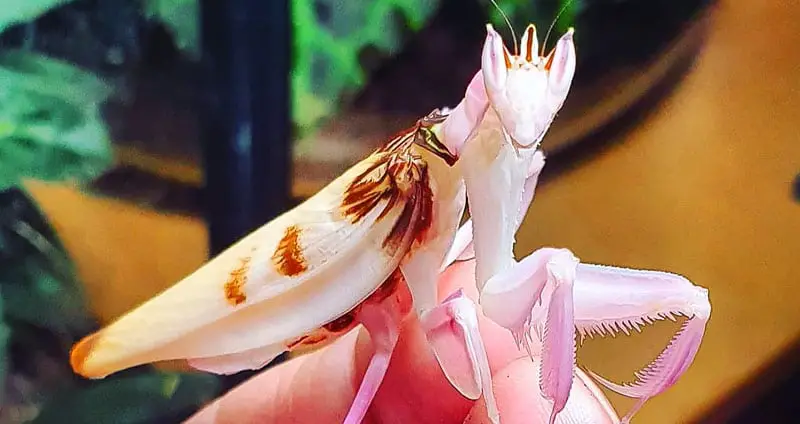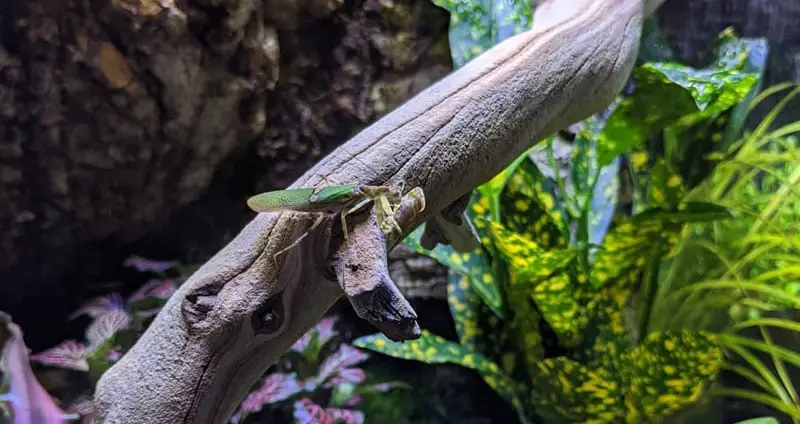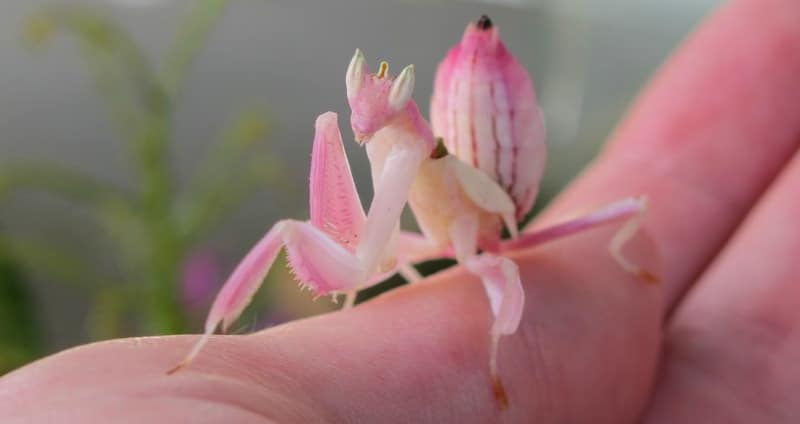The Orchid Mantis, or Hymenopus coronatus, is a beautiful pink mantis species that’s shaped and colored very similarly to an orchid flower — hence its name.
This species is very popular among both beginner and experienced mantis keepers alike due to its great personality and appearance that’s really second to none.
This guide will tell you exactly what you can expect with one of these curious creatures, including how to feed it, what it needs in an enclosure, and what their personality is like.
Table of Contents
Orchid Mantis Care Sheet
| Scientific Name |
Hymenopus coronatus |
| Species Type | Flower Mantis |
| Habitat | Tropical forests of Southeast Asia |
| Growth Rate | Fast, reaching maturity in just a few months |
| Adult Size | Females reach about 6 to 7 cm, while males only measure up to 3 cm. |
| Lifespan | Females live for around 8 to 9 months, while males only live around 5 to 6 months. |
| Enclosure | All mantes require an enclosure that’s at least 3 times their size in height and twice their size in width. The enclosure should have excellent ventilation, plenty of materials to climb, and lots of floor space. |
| Temp/Humidity | Should be kept at around 80°F with 60% to 80% humidity. |
| Diet | Feeding primarily on flying insects, the Orchid Mantis should be fed house flies / blue bottle flies with wild butterflies and hoverflies fed supplementary. |
| Temperament | Quiet species that mostly sits around and waits for prey. Males can act very skittish and often try and flee when you enter their enclosure. |
| Experience Level | Beginner – There are some caveats, but they’re overall easy to care for and don’t require much upkeep. |
| Average Cost | ~$50 per Orchid Mantis ootheca |
Orchid Mantis Appearance
If you’re looking for a beautiful mantis species, then look no further than the Orchid Mantis. Its design and coloration has made it a very popular pet. So popular, in fact, it’s even been included in the game Animal Crossing: New Horizons.
It should be noted that all specimens don’t look the same, so your mileage may vary. Some will end up being completely white, others entirely pink, and others somewhere in between.
The back of this mantis, along with its head, features brown accents that one would commonly observe on the inside of an orchid’s petals.
Not only do they have a unique pink coloration, but they also have physical characteristics that make them appear very similar to a flower.
Lobes on this species’ legs help to camouflage the long appendages and make them appear like a flower petal as well.
Males and females differ in coloration and design, however. Adult males have white wings that contrast a pinkish-orange body and have almost no lobes, while females have prominent lobes and vary in color.
Females also have a green spot on their back, while males have a brown spot.
They don’t always have this appearance, though. Orchid Mantis nymphs are colored dark orange with a black head and legs. They start to develop their pink color after a few molts.
In terms of sizing, females grow to be about 6 to 7 cm long, while males only grow up to about 3 cm. As their lifespan is shorter than females, males reach maturity quicker.

Orchid Mantis Temperament
It’s fortunate that the Orchid Mantis is so beautiful, as its temperament doesn’t necessarily match its beauty. In other words, it isn’t extremely exciting to own for some people, and this is due to its hunting style.
This is an ambush predator, meaning that spends a large portion of its time sitting around and waiting for prey to come near it.
The Orchid Mantis will find a plant that has flowers and attach itself to a twig with the claws of its rearmost legs. It will then sway side to side to attract small flies. These flies quickly come as they both mistake the spot on the back of the mantis for another fly and view the mantis as a large flower — better than the real flowers around it.
Once a larger fly lands nearby, the Orchid Mantis will reach out, grab, and bite into it.
In captivity, this is what this mantis species spends most of its time doing. However, they can also be observed climbing around their enclosure and exploring.
While this species is definitely described as “calm”, it can get a little flighty — especially males. Many owners note that their male mantes are very skittish and will try to fly away if they’re disturbed.
Housing The Orchid Mantis
Housing an Orchid Mantis isn’t very difficult, but it is one of the most important aspects of ownership. If an enclosure isn’t constructed well, it could be detrimental to the health of the mantis.
All that you need to do, though, is get a good mantis enclosure, add a few accessories to the inside, and keep the internal climate consistent.
Optimal Enclosure
The general rule of thumb is that a mantis enclosure should be at least 3 times the height of the mantis and at least twice as wide. However, it’s almost never a bad thing to go significantly bigger than this (within reason). More space is almost always better.
There are two enclosures that we’d recommend for an Orchid Mantis. First off is this Exo Terra 12″ x 12″ x 12″ enclosure which is very secure and provides plenty of room, accessibility, and breathability.
The next enclosure is this Zoo Med 10″ x 10″ x 12″ mesh enclosure, which caters more towards a mantis’ need to climb and latch onto walls and ceilings.
Both of these enclosures are great for a single adult Orchid Mantis, but they’ll need to be decorated differently. Specifically, the glass enclosure will need more climbing materials inside of it than the mesh enclosure.
Enclosure Decorations
The inside of an Orchid Mantis enclosure doesn’t need to have a lot of accessories, but many owners like to make their enclosures look as authentic and natural as possible.
Both glass and mesh enclosures require a bit of substrate lining the floor, such as coconut fiber. This can then be covered with some dry leaves, sticks, and fake plants.
Then, both enclosures need a variety of materials to climb on, with mesh enclosures requiring fewer materials. Many owners like to stand up a piece of cork bark vertically against one wall, and then diagonally stand up a large stick.
You’re able to get quite creative with this part. Just be sure to include lots of climbing space while not making the enclosure too cramped and closed off.

Enclosure Temperature/Humidity
This species of mantis is native to the tropical forests of Southeast Asia — a region that’s quite warm and humid. Because of this, their enclosure needs to mimic those conditions.
The ideal temperature for the Orchid Mantis is around 80°F, but it can drop to as low as 75°F and still be fine. Fortunately, this is around room temperature for a lot of people.
If your house is below this range, you may need to provide supplemental heating through either a space heater for the room or a gentle heat lamp that doesn’t emit light.
Humidity levels for this species need to be kept quite high, anywhere between 60% and 80%. Nymphs can be kept at lower humidities and only need their enclosures misted once per week. As they grow, misting should become more frequent.
It’s recommended that you use a thermometer/hygrometer to monitor conditions of the enclosure and make changes as needed.
Diet
An Orchid Mantis’ diet should be similar to its natural diet — a diet that primarily consists of flying insects. As this is an ambush predators that’s evolved to hunt flying insects, it’s essential that you provide those as the main food source.
Houseflies and blue bottle flies should make up the majority of their diet, while butterflies and hoverflies can be used to diversify things. Crickets and flour worms can also be fed, but they’re not optimal.
Nymphs require a different diet consisting of drosophila, wax worms, and flightless fruit flies.
Health Concerns
While there are some mantes that are difficult to care for, such as the Devil’s Flower Mantis, the Orchid Mantis is a bit easier. However, there are still things that you should know.
First of all, it’s important to make sure that the enclosure is well-ventilated with proper temperatures and humidities. While this is important for several reasons, it’s most important in regard to its molt.
Failed molts are common killer of praying mantes. Proper temperature, humidity, ventilation, and free space all help to make the molt much easier and greatly increases the chances of success.
Stress can also be a big killer for mantes, so do everything that you can to keep stress to a minimum. Ensure that their enclosures are large and easy to climb, keep feeding regular and sufficient, and don’t handle them very frequently.
Finally, a cause of death with the Orchid Mantis is its own species. This is a cannibalistic species, so they need to be kept separate as soon as they grow out of their very early nymph stages.
Orchid Mantis For Sale & Price
This mantis is beautiful in appearance and highly desired by a lot of people, but it’s not overly expensive to purchase. It’s definitely not the cheapest species available, but it’s accessible to virtually anybody that wants one.
You can find an Orchid Mantis for sale on many only marketplaces and message boards. Prices can vary, especially when purchasing several at once, but it’s not uncommon to find an unsexed nymph for sale for around $40.
Prices increase from there, with sexed sub-adult males selling for around $60 and females selling upwards of $100.
For an animal that lives for less than a year, this can be a substantial amount of money. However, for the beauty that you get with that money, it can be fairly easy to justify such a purchase.
Fun Orchid Mantis Facts
- Orchid Mantes can change its color between pink and brown depending on its environment.
- First stage nymphs mimic bugs from the Reduviidae family, which taste terrible and have a strong bite.
- Mating can take anywhere from several hours to several days, with the male remaining on the female’s back the entire time.
- The Orchid Mantis has been observed having higher rates of hunting success by perching near leaves/flowers that look nothing like it.
- A study showed that the Orchid Mantis attracted more bees than any other flower in its vicinity.

